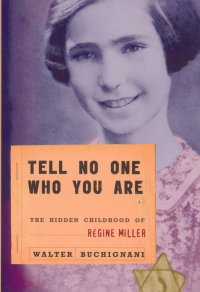| ________________
CM . . .
. Volume XV Number 6. . . .November 7, 2008 
 |
Tell No One Who You Are: The Hidden Childhood of Régine Miller.
Walter Buchignani.
Toronto, ON: Tundra, 2008.
185 pp., pbk., $14.99.
ISBN 978-0-88776-817-0.
Subject Headings:
Miller, Régine-Juvenile literature.
Belgium-History-German occupation, 1940-1945-Biography-Juvenile literature.
Hidden children (Holocaust) Belgium-Biography-Juvenile literature.
Jewish children-Belgium-Biography-Juvenile literature.
World War, 1939-1945-Personal narratives, Jewish-Juvenile literature.
Grades 4-8 / Ages 9-13.
Review by Daphne Hamilton-Nagorsen.
*** /4
|
| |
|

excerpt:
Before her father could knock, the door opened. Standing behind it was a heavyset woman, her white hair tied in a bun. She was so big, she almost filled the door frame. She didn't say a word, but just looked over with a severe expression. The real Madame André looked nothing like the frail little woman Régine had imagined on the tram. She did not even look friendly.
"I am Miller," her father said.
"Come in quick!" Madame André said and stepped back to let them in. Régine saw her look nervously up and down the street before locking the door.
She was no more talkative inside the house than she had been in greeting them at the door. She did not ask any questions or invite her father to take his coat off. The three of them stood inside in silence. The woman was waiting for something. Régine's father reached into his coat pocket, pulled out an envelope and handed it to Madame André. Without comment, she took it, looked inside and nodded. Then she turned to Régine. "I'll show you to your room."
Tell No One Who You Are is the story of Régine Miller and her life in Belgium before and after the German invasion of 1940. Régine is Jewish and sees firsthand all the restrictions and changes the Nazis bring. Eventually, her brother is taken away, and Régine is sent to live with other people in order to protect her. Régine lives in four different locations before the war ends. Some of the families she lives with know she is Jewish but most do not. Régine must deal with the aftermath of the war and what has happened to her family.
Tell No One Who You Are is written in a very simple style, like someone is telling the story on the radio or writing it in a diary. This approach gives the narration a childlike feel and allows it to feel reflective. The writing style is very effective for the narration as the reader is carried along with Régine as she goes from one place to another. The writing style also does well at conveying the hopelessness and fear that Régine feels as the war shows no signs of ending, as her father fails to visit her, and as she must live a life of lies in order to survive.
The descriptions in Tell No One Who You Are are excellent. They are simple but very graphic and manage to convey an image in only a few words. The description of Madame André in the excerpt is a good example of the descriptions. The reader can easily imagine Madame André looming in the doorway and how imposing she must have seemed to Régine. More detailed descriptions are not necessary and, in fact, would take away from the narrative style.
Tell No One Who You Are covers not only the period immediately before the German invasion of Belgium, but it also tells about the aftermath of the war for Régine and other hidden children, many of whom were orphans. The book does not hide what these children faced and what they went through, before and after the war. There is also a section at the end which gives a brief overview of Jewish children in Belgium during the war, details about Solidarité Juive (a communist organization to which Régine's father belonged), and what happened to the families of both Régine and a member of the Solidarité who helped Régine during the war. Although the majority of Régine's tale is unhappy, Tell No One Who You Are does not try to whitewash or sugarcoat the events.
Tell No One Who You Are was created from interviews with Régine Miller that were conducted over two-and-a-half years by Walter Buchignani after he met Régine at the first International Gathering of Children Hidden During World War II. The time and effort that Walter Buchignani put into Tell No One Who You Are is reflected throughout the book in the small details that are included, down to the clothes that Régine wore and the jam she helped a neighbour make. There are also some photos which were saved for Régine by a neighbour after her family's apartment was raided by the Gestapo. The pictures add an extra dimension to the story, showing a happy family before the war came.
Tell No One Who You Are is a good book to show what happened to children, especially Jewish children, during World War II. It takes the reader inside the life of one child who survived and invites thought about all the other children caught up in the war. Many were orphaned, and, as Régine says at the end of the book, "Many were babies and too young to remember their parents when they were in hiding. I felt sorry for them. I had my memories." This is a statement that will resonate with readers long after they have finished this book.
Recommended.
Daphne Hamilton-Nagorsen is a graduate of the School of Library, Archival and Information Studies at UBC, Vancouver, BC.

To comment
on this title or this review, send mail to cm@
Copyright © the Manitoba Library Association. Reproduction for personal
use is permitted only if this copyright notice is maintained. Any
other reproduction is prohibited without permission.
NEXT REVIEW |
TABLE OF CONTENTS FOR THIS ISSUE
- November 7, 2008.
AUTHORS |
TITLES |
MEDIA REVIEWS |
PROFILES |
BACK ISSUES |
SEARCH |
CMARCHIVE |
HOME |
